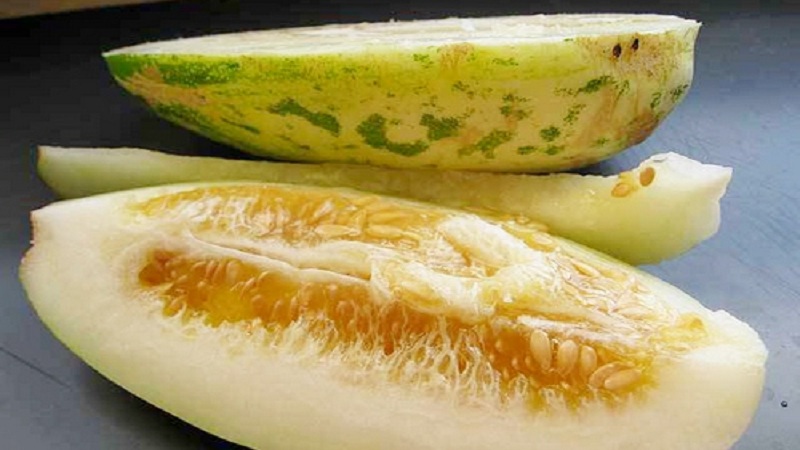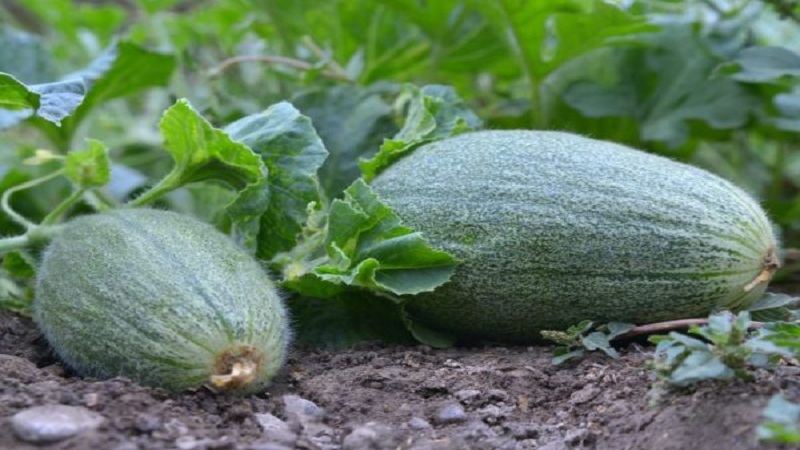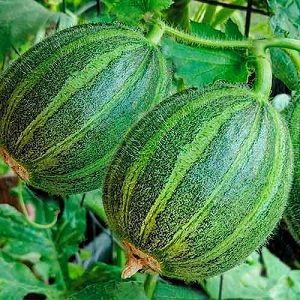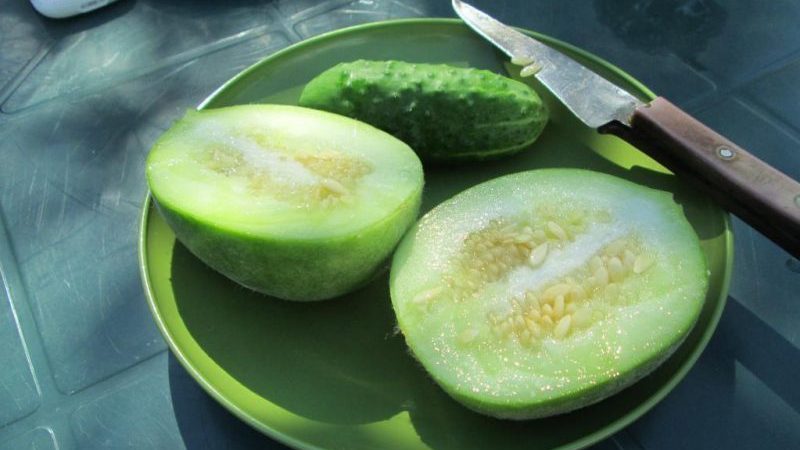What is cucumber, how is it grown and eaten
The product of modern breeding - ogurdynya - refers to early maturing hybrids. The crop is highly regarded for its unusual taste and high yield. The fruits have an amazing ability to change shape and color during ripening.
In this article, we will tell you about the distinctive features of the cucumber, the methods of growing, the rules of care, and the taste. You will learn what the pulp is good for and how to cook it.
The content of the article
Feature and Description
Ogurdynia - what is it? Gardeners still have not come to a consensus: some argue that this is a vegetable-fruit of tropical origin, others are sure that this is a hybrid obtained by crossing a cucumber and a melon.
Gourd cultivation began in Central Asia. Breeders got the hybrid by crossing early melon varieties and unpretentious cucumber varieties. The plant resembles a cucumber bush, but with larger leaves, and reaches two meters in height... It is grown horizontally or vertically.
Fruit shape and taste directly depend on the stage of ripeness. Early fruits are similar to cucumbers, only with a thinner skin. The size ranges from 8 to 12 cm. The color is light green, the surface is soft edged.
Ripe fruits are shaped like a melon and grow to 60–80 cm in length. The average weight is 6–8 kg. The skin turns yellow and becomes covered with greenish stripes. When cut, a small number of seeds are visible inside.
In the photo - ripe ogurdina fruits.

reference... The peel of the fruit is thin, like an apple. Therefore, they are stored no longer than 1.5 months in a refrigerator or basement.
Taste qualities
At an early stage of ripening, cucumber practically does not differ from cucumbers - neither aroma nor taste.
As they ripen, the fruits become melons-like. The sweet, juicy pulp of a yellow-orange hue exudes a delicate aroma and has a breathtaking taste. Taste is difficult to convey in words, the pronounced taste of melon is mixed with notes of banana, orange, cucumber and honey.
How is it eaten
Fruits at the stage of milk ripeness are suitable for fresh consumption. Vegetable salads are prepared from them, pickled, salted. The product does not lose its taste and retains its original aroma and color.
Ripe fruits make delicious jams, compotes and candied fruits. But it is most delicious and healthier to use them fresh.
Composition and properties
Ogurdynia is characterized by high nutritional value, has a rich chemical composition:
- vitamins A, C, E, PP, group B;
- minerals: magnesium, sodium, calcium, potassium, iron.
Benefit and harm
The use of cucumber fruits has a beneficial effect on the human body:
- destroys free radicals;
- has an anti-sclerotic effect;
- normalizes the digestive system;
- removes excess salts and cholesterol;
- speeds up metabolism;
- rejuvenates the body;
- has a mild choleretic and diuretic effect.
Information about the dangers of ogurdin is not provided. Individual intolerance is possible. Therefore, introduce a new product into the diet with caution.
It is interesting:
How to make aromatic and tasty melon and orange jam for the winter.
How does melon affect the intestines: weakens or strengthens?
Varieties

Gourd varieties differ in fruit shape, color, smell and taste. There are 15 varieties in total.
Varieties for those who prefer large-fruited crops:
- Manduria;
- Green;
- White;
- Orenburg;
- Special;
- Candy.
Fruits of an unusual color give varieties:
- Tarot;
- Duck Green Mark;
- Melanflehuosus Sahio.
Smooth, slightly elongated, with incredibly sweet and fragrant pulp, fruits are obtained from varieties:
- Orange banana;
- Fizano;
- Banana;
- Caramel;
- Alexandria;
- New;
- Pineapple.
reference... The silver melon, or Armenian cucumber, is often called the cucumber. But these cultures are different. Ogurdyn turns into a melon as it ripens. The Armenian cucumber looks like a long cucumber with a ribbed surface of green or white. When overripe, the fruits turn yellow and lose their taste.
Features of growing and care
Growing and caring for cucumbers requires compliance with several conditions to achieve optimal results and a rich harvest:
- The culture loves the sun, so a dry and warm climate is ideal for cultivation.
- The soil should be fertile and loose. It is fertilized with compost, humus, potassium sulfate and ammonium nitrate.
- Another important point is soil moisture. Correct watering is ensured at the initial stage of seedling growing.
Seed preparation and seedling growing
Before sowing, the seeds are soaked in a pale pink solution of potassium permanganate for 30 minutes. This promotes the speedy germination of the seed and allows you to identify defective seeds.
Seedlings are grown by sowing seeds directly into the ground or in disposable cups. It all depends on the region of residence.
Sowing in the ground is practiced in areas with a warm and mild climate. Seeds are sown in the first ten days of May with an interval of 50–100 cm to a depth of 2 cm. After 5–7 leaves have formed, the top is dived so that the plant releases lateral shoots. Then they are sprinkled with earth in order to strengthen the rhizome.
In regions where warm weather sets in later, and summer is short, planting using seedlings is preferred. For this purpose, they take peat or plastic cups and fill them with moist universal soil or special for vegetable crops. One seed is placed in each container to a depth of 2 cm, covered with plastic wrap and left in a well-lit place. The first shoots appear in 5-7 days. In a month, the seedlings will be ready for planting in a greenhouse or vegetable garden.
Care
Gourd care consists of several points:

- Water with warm water as the soil dries, but at least twice a week outdoors and once in a greenhouse. Reduce watering during the ripening period so that the fruits are sweet, not watery.
- Weeding regularly to remove excess grass and weeds. Loosen the soil at the same time as weeding.
- Add overgrown shoots as necessary.
- Apply fertilizers at the initial stage of growth until the ovary appears once every 2 weeks. The best fertilizers are ash, mullein and minerals. Then stop feeding.
Ripening and harvesting terms
When does the fruit ripen and when can it be harvested? Ogurdynia ripens quickly, fruits begin to be harvested 1.5–2 months after planting. If small cracks appear on them, from which liquid oozes, then you can tear it off.
Fruiting continues until the end of September and ends with the onset of frost. 18-20 fruits weighing from 1 to 3 kg are harvested from one bush.
Possible growing difficulties
The main difficulty in growing is to provide enough water without waterlogging the soil. An excess of moisture threatens with ovary decay and bacterial diseases. Before watering the plant, lift the leaves and inspect the soil. If it is still damp, wait for the watering.
When choosing a growing method - on the ground or on a trellis - take into account the fact that ripe fruits, under their own weight, are easily separated from the lashes.Falling to the ground, they break and in the future are only suitable for obtaining seeds.
Despite the fact that gourd is a thermophilic culture, it does not tolerate excessive heat. Therefore, when grown in a greenhouse, plants often shed their ovary at extremely high temperatures.
The sweet fruit with a delicate skin is a favorite delicacy for pigeons, sparrows and starlings. To scare away birds, experienced gardeners install mirror-coated turntables, wind chimes and other devices.
What to cook
Ogurdynia is a universal product. In addition to fresh consumption, it is suitable for preparing salads, pickled appetizers, desserts, preserves, jams and compotes.
We offer recipes for delicious jam and refreshing compote. The components can be changed according to your look, you can add any spices, fruits and berries.

Jam
Ingredients:
- cucumber - 1 pc.;
- sugar - 350 g;
- star anise - 1 asterisk.;
- juice and zest of 1 lemon.
Wash the fruit, cut into two halves and remove the seeds. Rinse under the tap and cut into slices. The skin does not need to be removed, it is very soft.
Place the pulp in an enamel bowl, add star anise and cover with granulated sugar. Put on low heat and simmer until sugar is completely dissolved. Add lemon juice and zest as soon as it starts to boil. Stir, boil for 5 minutes and place in jars. Cap tightly and store in a cool place.
Compote
Ingredients:
- cucumber - 1 pc.;
- citric acid - 1 pinch;
- sugar - to taste (fruits are very sweet);
- distilled water - 3 liters.
Wash the fruit, remove the shift and chop coarsely. Boil water and sweeten to taste. Transfer the pulp into it, add citric acid and cook for no longer than 10-15 minutes. Serve chilled with a mint leaf.
Advice... Compote can be prepared for the winter. To do this, pour the boiling liquid into clean cans and roll up with tin lids. Store in a cellar.
Reviews
Everyone who has tried to grow cucumber leaves positive reviews.
Valentina, Yelets: «Last year my son sent the seeds of the Larton F1 pickle. Before that, I had never grown and did not even know about its existence. After reading the recommendations for growing, I confidently got down to business. Planted through seedlings in open ground. The seedlings looked exactly like cucumbers. Flowering was abundant, there were many ovaries. The fruit looked more like a large pear. What was our surprise when we tasted the ripe fruit - real honey melon, fragrant and very sweet ”.
Oleg, Lipetsk: “I love to experiment and from time to time I try to grow some new plant in my country house. Three years ago, I first tried to cultivate a gourd. Painfully I heard about her wonderful taste. I was more than satisfied with the result, this year I also plan to plant. Already prepared the seedlings. The fruits are delicious, the pulp is sweet and fragrant. Sometimes we prepare salads from unripe fruits, but we always wait until they are fully ripe. "
Read also:
How and when to form a melon in the open field correctly.
What is good about the Ethiopian melon and why it is worth growing it yourself.
Conclusion
A cucumber crossed with a melon, called a cucumber, has not yet become widespread. The reason for this is the distrust of gardeners in little-known plants. After all, to grow a culture and get a harvest, you have to invest a lot of effort and patience, and the result is not always successful. But those who have tried to grow this hybrid are satisfied. Subject to the rules of agricultural technology, the culture pleases with a rich harvest.